MBA502 Assessment 1: Self-Assessment and Learning Outcomes Essay
VerifiedAdded on 2022/10/11
|9
|1542
|13
Essay
AI Summary
This essay reflects on the learning outcomes derived from self-assessments, focusing on emotional and cultural intelligence. The student completed the Global Emotional Intelligence Test (GEIT) and Daniel Goleman's EQ test, and had two friends complete the same tests for comparative analysis. The essay then uses the Johari Window model to discuss the results, exploring the concepts of self-awareness, social awareness, and relationship management. The analysis highlights strengths and weaknesses identified through the tests, emphasizing the importance of self-awareness and the ability to adapt to diverse situations to become a responsible global citizen. The essay also underscores the role of feedback and open communication in personal development and achieving success in a culturally diverse environment.
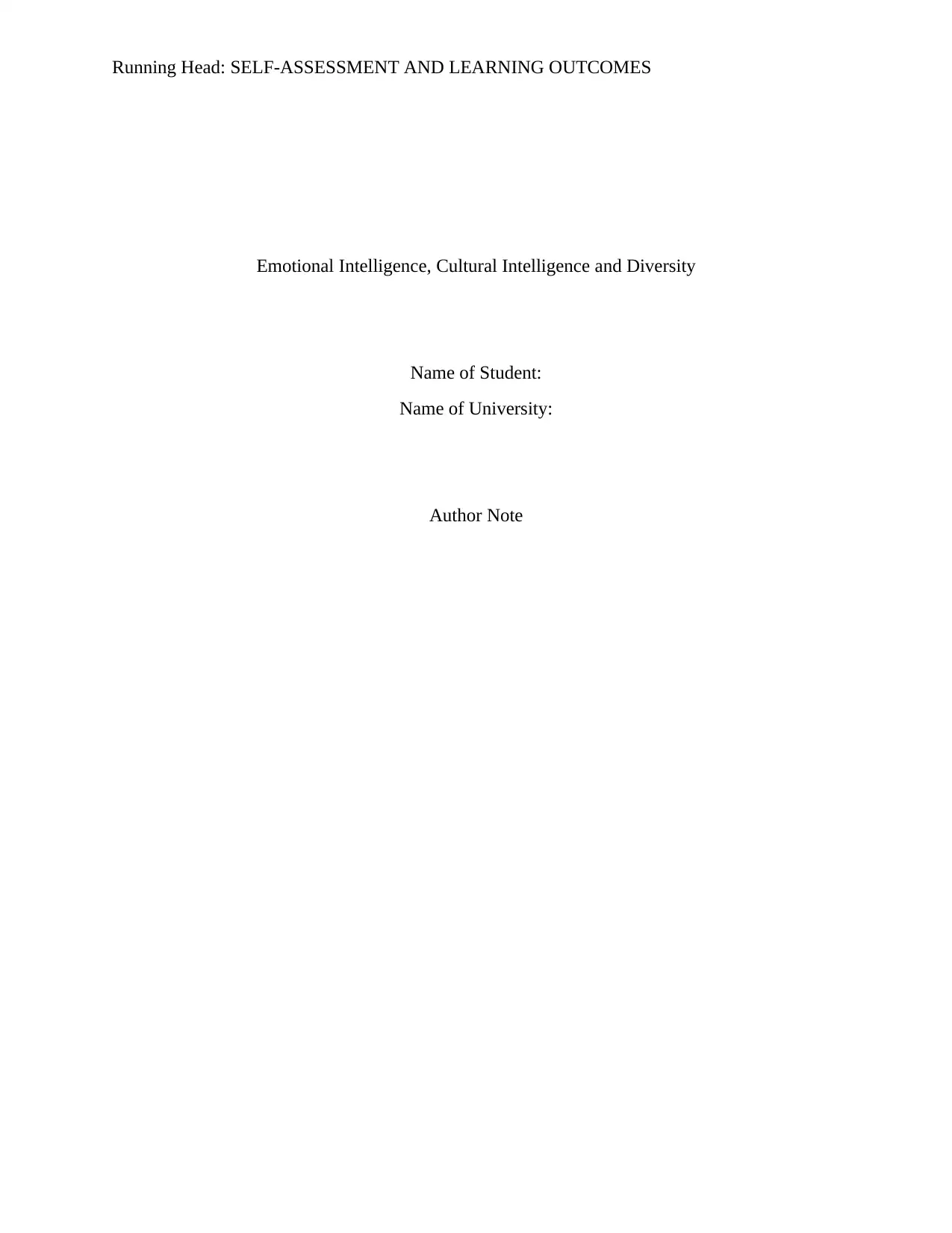
Running Head: SELF-ASSESSMENT AND LEARNING OUTCOMES
Emotional Intelligence, Cultural Intelligence and Diversity
Name of Student:
Name of University:
Author Note
Emotional Intelligence, Cultural Intelligence and Diversity
Name of Student:
Name of University:
Author Note
Paraphrase This Document
Need a fresh take? Get an instant paraphrase of this document with our AI Paraphraser
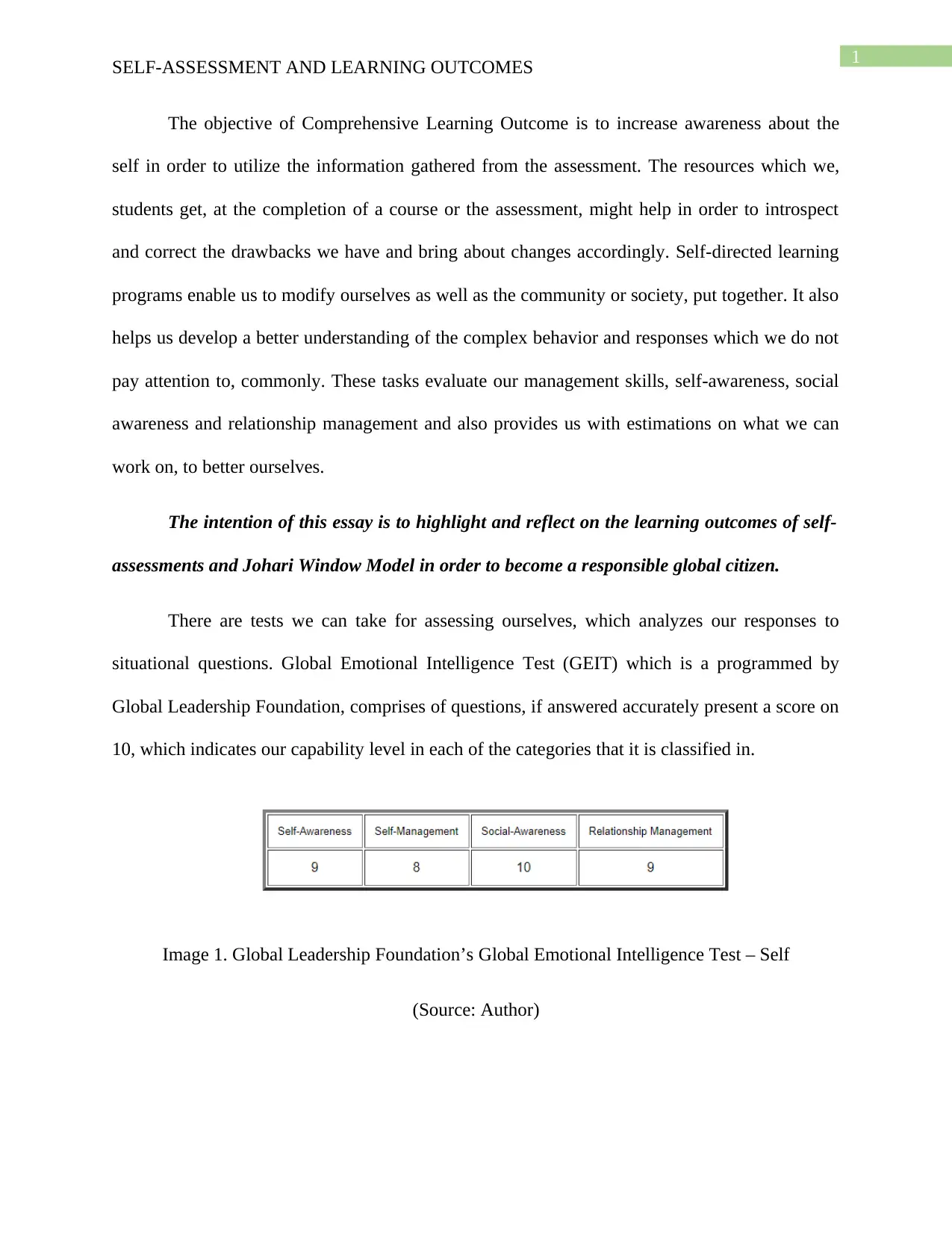
1
SELF-ASSESSMENT AND LEARNING OUTCOMES
The objective of Comprehensive Learning Outcome is to increase awareness about the
self in order to utilize the information gathered from the assessment. The resources which we,
students get, at the completion of a course or the assessment, might help in order to introspect
and correct the drawbacks we have and bring about changes accordingly. Self-directed learning
programs enable us to modify ourselves as well as the community or society, put together. It also
helps us develop a better understanding of the complex behavior and responses which we do not
pay attention to, commonly. These tasks evaluate our management skills, self-awareness, social
awareness and relationship management and also provides us with estimations on what we can
work on, to better ourselves.
The intention of this essay is to highlight and reflect on the learning outcomes of self-
assessments and Johari Window Model in order to become a responsible global citizen.
There are tests we can take for assessing ourselves, which analyzes our responses to
situational questions. Global Emotional Intelligence Test (GEIT) which is a programmed by
Global Leadership Foundation, comprises of questions, if answered accurately present a score on
10, which indicates our capability level in each of the categories that it is classified in.
Image 1. Global Leadership Foundation’s Global Emotional Intelligence Test – Self
(Source: Author)
SELF-ASSESSMENT AND LEARNING OUTCOMES
The objective of Comprehensive Learning Outcome is to increase awareness about the
self in order to utilize the information gathered from the assessment. The resources which we,
students get, at the completion of a course or the assessment, might help in order to introspect
and correct the drawbacks we have and bring about changes accordingly. Self-directed learning
programs enable us to modify ourselves as well as the community or society, put together. It also
helps us develop a better understanding of the complex behavior and responses which we do not
pay attention to, commonly. These tasks evaluate our management skills, self-awareness, social
awareness and relationship management and also provides us with estimations on what we can
work on, to better ourselves.
The intention of this essay is to highlight and reflect on the learning outcomes of self-
assessments and Johari Window Model in order to become a responsible global citizen.
There are tests we can take for assessing ourselves, which analyzes our responses to
situational questions. Global Emotional Intelligence Test (GEIT) which is a programmed by
Global Leadership Foundation, comprises of questions, if answered accurately present a score on
10, which indicates our capability level in each of the categories that it is classified in.
Image 1. Global Leadership Foundation’s Global Emotional Intelligence Test – Self
(Source: Author)
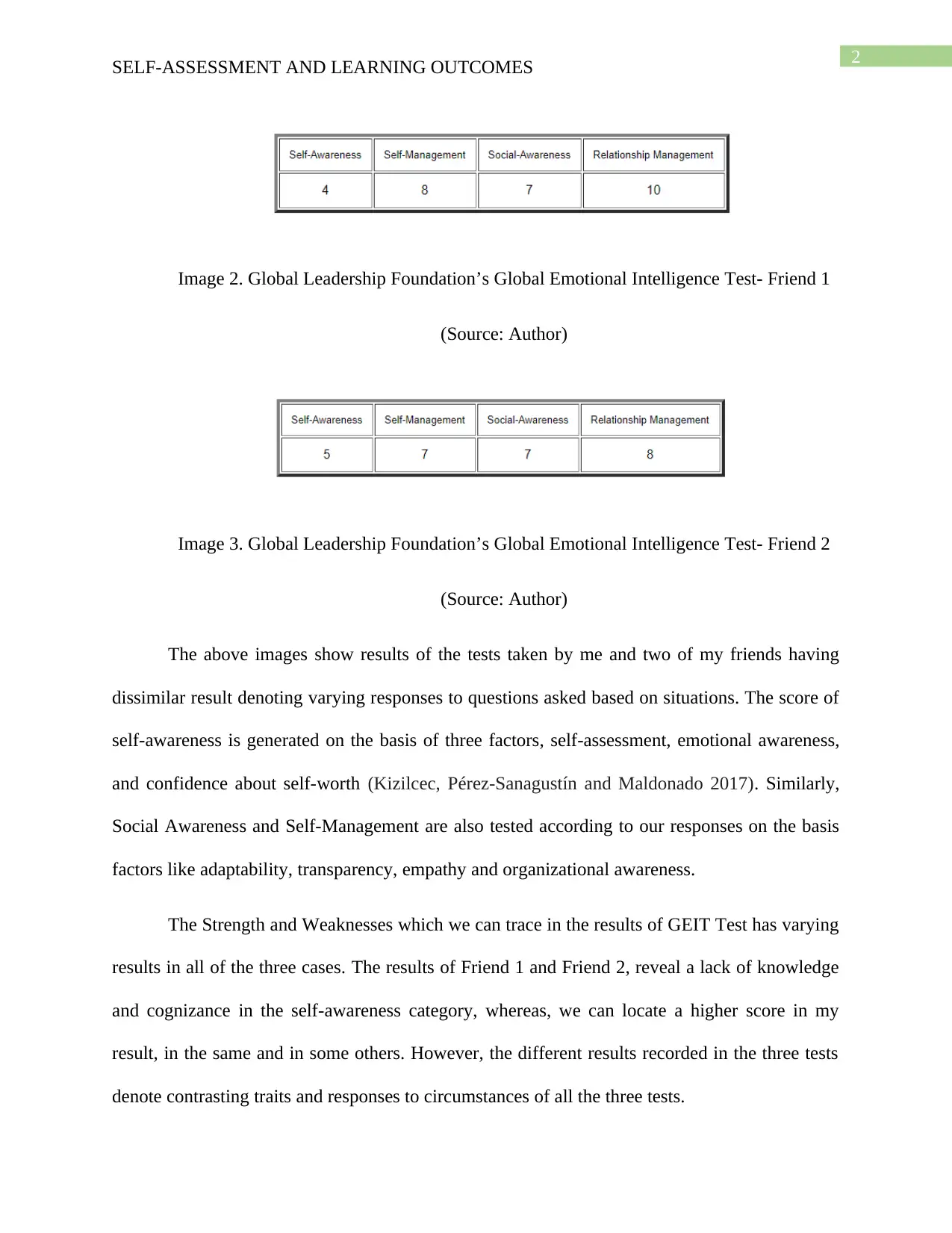
2
SELF-ASSESSMENT AND LEARNING OUTCOMES
Image 2. Global Leadership Foundation’s Global Emotional Intelligence Test- Friend 1
(Source: Author)
Image 3. Global Leadership Foundation’s Global Emotional Intelligence Test- Friend 2
(Source: Author)
The above images show results of the tests taken by me and two of my friends having
dissimilar result denoting varying responses to questions asked based on situations. The score of
self-awareness is generated on the basis of three factors, self-assessment, emotional awareness,
and confidence about self-worth (Kizilcec, Pérez-Sanagustín and Maldonado 2017). Similarly,
Social Awareness and Self-Management are also tested according to our responses on the basis
factors like adaptability, transparency, empathy and organizational awareness.
The Strength and Weaknesses which we can trace in the results of GEIT Test has varying
results in all of the three cases. The results of Friend 1 and Friend 2, reveal a lack of knowledge
and cognizance in the self-awareness category, whereas, we can locate a higher score in my
result, in the same and in some others. However, the different results recorded in the three tests
denote contrasting traits and responses to circumstances of all the three tests.
SELF-ASSESSMENT AND LEARNING OUTCOMES
Image 2. Global Leadership Foundation’s Global Emotional Intelligence Test- Friend 1
(Source: Author)
Image 3. Global Leadership Foundation’s Global Emotional Intelligence Test- Friend 2
(Source: Author)
The above images show results of the tests taken by me and two of my friends having
dissimilar result denoting varying responses to questions asked based on situations. The score of
self-awareness is generated on the basis of three factors, self-assessment, emotional awareness,
and confidence about self-worth (Kizilcec, Pérez-Sanagustín and Maldonado 2017). Similarly,
Social Awareness and Self-Management are also tested according to our responses on the basis
factors like adaptability, transparency, empathy and organizational awareness.
The Strength and Weaknesses which we can trace in the results of GEIT Test has varying
results in all of the three cases. The results of Friend 1 and Friend 2, reveal a lack of knowledge
and cognizance in the self-awareness category, whereas, we can locate a higher score in my
result, in the same and in some others. However, the different results recorded in the three tests
denote contrasting traits and responses to circumstances of all the three tests.
⊘ This is a preview!⊘
Do you want full access?
Subscribe today to unlock all pages.

Trusted by 1+ million students worldwide
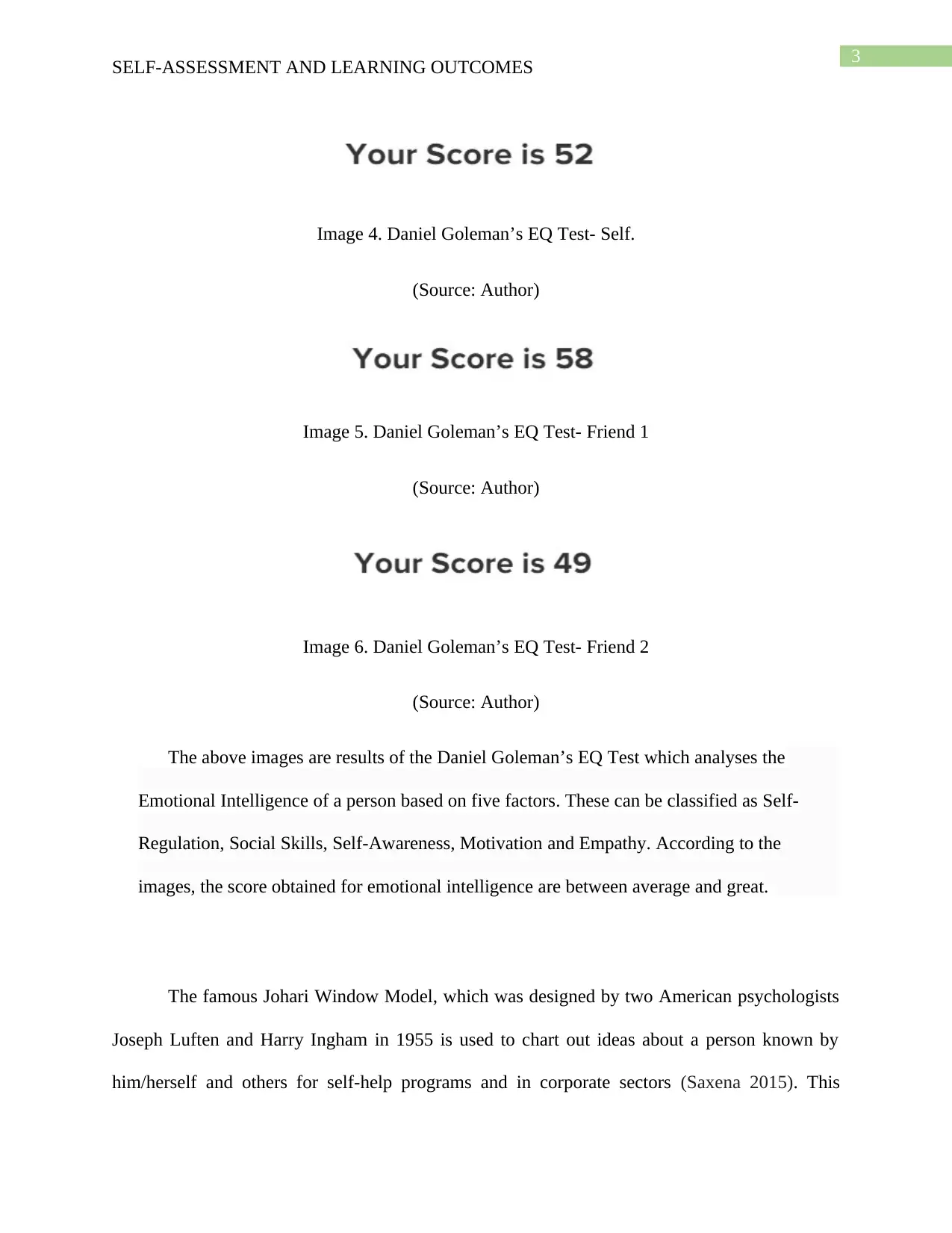
3
SELF-ASSESSMENT AND LEARNING OUTCOMES
Image 4. Daniel Goleman’s EQ Test- Self.
(Source: Author)
Image 5. Daniel Goleman’s EQ Test- Friend 1
(Source: Author)
Image 6. Daniel Goleman’s EQ Test- Friend 2
(Source: Author)
The above images are results of the Daniel Goleman’s EQ Test which analyses the
Emotional Intelligence of a person based on five factors. These can be classified as Self-
Regulation, Social Skills, Self-Awareness, Motivation and Empathy. According to the
images, the score obtained for emotional intelligence are between average and great.
The famous Johari Window Model, which was designed by two American psychologists
Joseph Luften and Harry Ingham in 1955 is used to chart out ideas about a person known by
him/herself and others for self-help programs and in corporate sectors (Saxena 2015). This
SELF-ASSESSMENT AND LEARNING OUTCOMES
Image 4. Daniel Goleman’s EQ Test- Self.
(Source: Author)
Image 5. Daniel Goleman’s EQ Test- Friend 1
(Source: Author)
Image 6. Daniel Goleman’s EQ Test- Friend 2
(Source: Author)
The above images are results of the Daniel Goleman’s EQ Test which analyses the
Emotional Intelligence of a person based on five factors. These can be classified as Self-
Regulation, Social Skills, Self-Awareness, Motivation and Empathy. According to the
images, the score obtained for emotional intelligence are between average and great.
The famous Johari Window Model, which was designed by two American psychologists
Joseph Luften and Harry Ingham in 1955 is used to chart out ideas about a person known by
him/herself and others for self-help programs and in corporate sectors (Saxena 2015). This
Paraphrase This Document
Need a fresh take? Get an instant paraphrase of this document with our AI Paraphraser
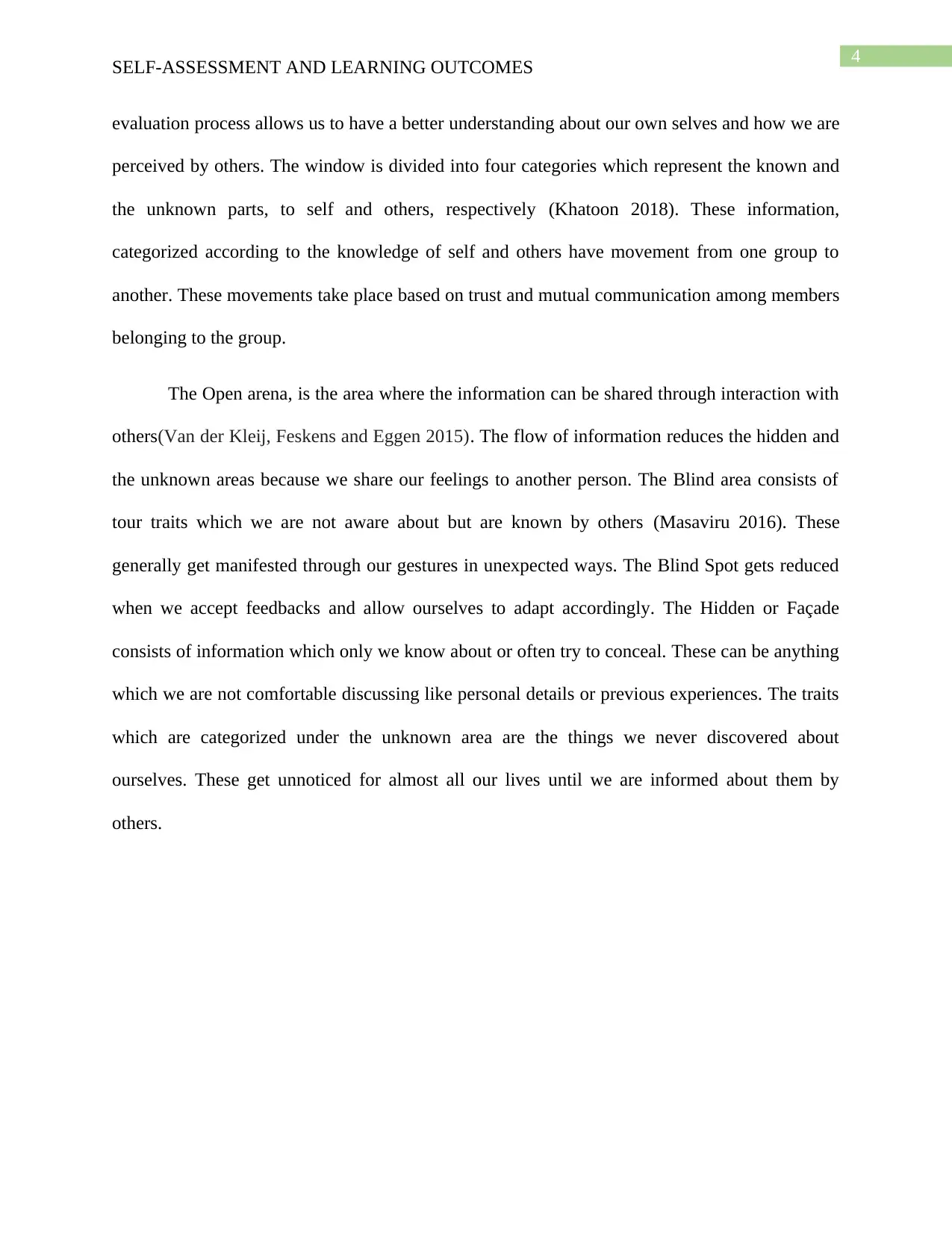
4
SELF-ASSESSMENT AND LEARNING OUTCOMES
evaluation process allows us to have a better understanding about our own selves and how we are
perceived by others. The window is divided into four categories which represent the known and
the unknown parts, to self and others, respectively (Khatoon 2018). These information,
categorized according to the knowledge of self and others have movement from one group to
another. These movements take place based on trust and mutual communication among members
belonging to the group.
The Open arena, is the area where the information can be shared through interaction with
others(Van der Kleij, Feskens and Eggen 2015). The flow of information reduces the hidden and
the unknown areas because we share our feelings to another person. The Blind area consists of
tour traits which we are not aware about but are known by others (Masaviru 2016). These
generally get manifested through our gestures in unexpected ways. The Blind Spot gets reduced
when we accept feedbacks and allow ourselves to adapt accordingly. The Hidden or Façade
consists of information which only we know about or often try to conceal. These can be anything
which we are not comfortable discussing like personal details or previous experiences. The traits
which are categorized under the unknown area are the things we never discovered about
ourselves. These get unnoticed for almost all our lives until we are informed about them by
others.
SELF-ASSESSMENT AND LEARNING OUTCOMES
evaluation process allows us to have a better understanding about our own selves and how we are
perceived by others. The window is divided into four categories which represent the known and
the unknown parts, to self and others, respectively (Khatoon 2018). These information,
categorized according to the knowledge of self and others have movement from one group to
another. These movements take place based on trust and mutual communication among members
belonging to the group.
The Open arena, is the area where the information can be shared through interaction with
others(Van der Kleij, Feskens and Eggen 2015). The flow of information reduces the hidden and
the unknown areas because we share our feelings to another person. The Blind area consists of
tour traits which we are not aware about but are known by others (Masaviru 2016). These
generally get manifested through our gestures in unexpected ways. The Blind Spot gets reduced
when we accept feedbacks and allow ourselves to adapt accordingly. The Hidden or Façade
consists of information which only we know about or often try to conceal. These can be anything
which we are not comfortable discussing like personal details or previous experiences. The traits
which are categorized under the unknown area are the things we never discovered about
ourselves. These get unnoticed for almost all our lives until we are informed about them by
others.
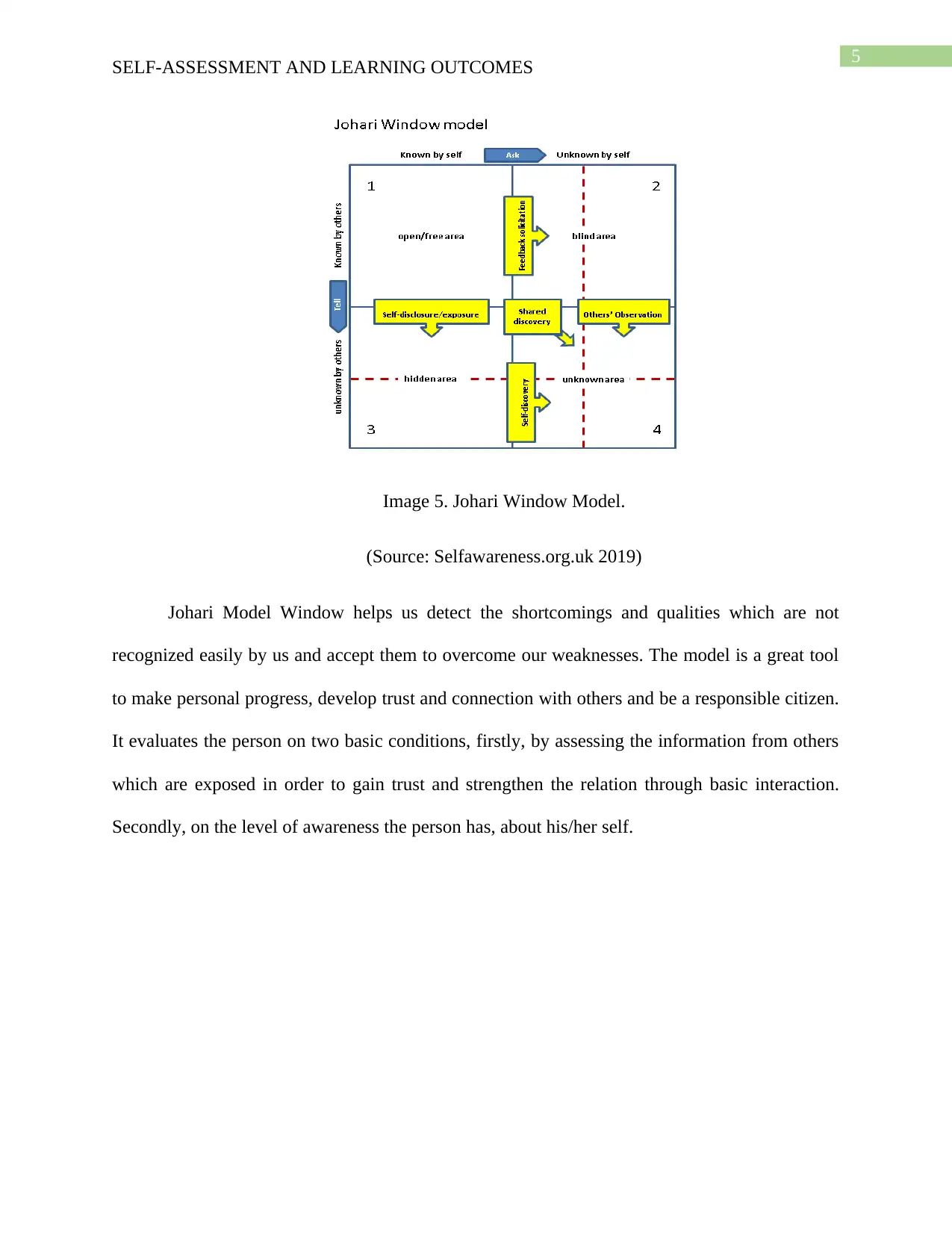
5
SELF-ASSESSMENT AND LEARNING OUTCOMES
Image 5. Johari Window Model.
(Source: Selfawareness.org.uk 2019)
Johari Model Window helps us detect the shortcomings and qualities which are not
recognized easily by us and accept them to overcome our weaknesses. The model is a great tool
to make personal progress, develop trust and connection with others and be a responsible citizen.
It evaluates the person on two basic conditions, firstly, by assessing the information from others
which are exposed in order to gain trust and strengthen the relation through basic interaction.
Secondly, on the level of awareness the person has, about his/her self.
SELF-ASSESSMENT AND LEARNING OUTCOMES
Image 5. Johari Window Model.
(Source: Selfawareness.org.uk 2019)
Johari Model Window helps us detect the shortcomings and qualities which are not
recognized easily by us and accept them to overcome our weaknesses. The model is a great tool
to make personal progress, develop trust and connection with others and be a responsible citizen.
It evaluates the person on two basic conditions, firstly, by assessing the information from others
which are exposed in order to gain trust and strengthen the relation through basic interaction.
Secondly, on the level of awareness the person has, about his/her self.
⊘ This is a preview!⊘
Do you want full access?
Subscribe today to unlock all pages.

Trusted by 1+ million students worldwide
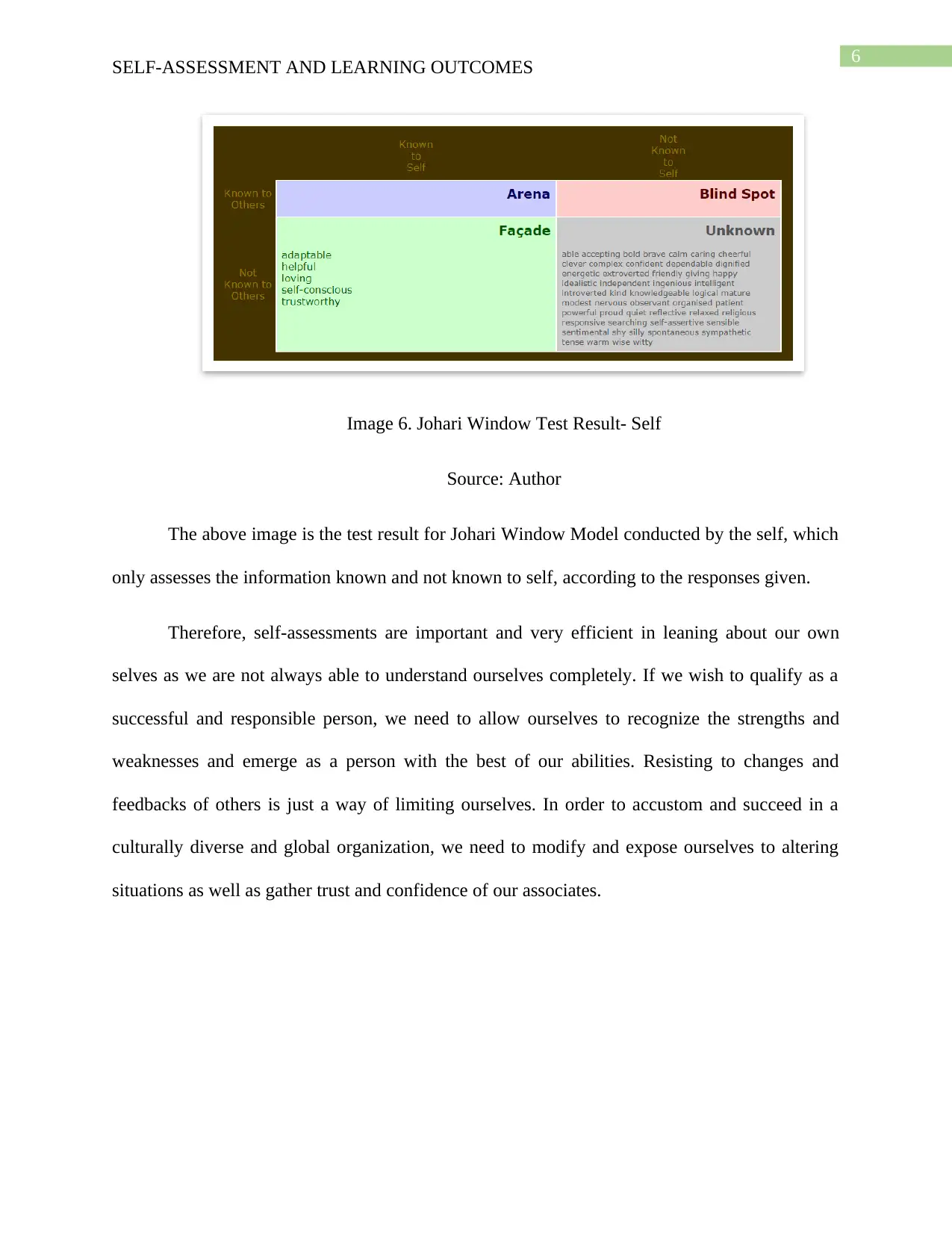
6
SELF-ASSESSMENT AND LEARNING OUTCOMES
Image 6. Johari Window Test Result- Self
Source: Author
The above image is the test result for Johari Window Model conducted by the self, which
only assesses the information known and not known to self, according to the responses given.
Therefore, self-assessments are important and very efficient in leaning about our own
selves as we are not always able to understand ourselves completely. If we wish to qualify as a
successful and responsible person, we need to allow ourselves to recognize the strengths and
weaknesses and emerge as a person with the best of our abilities. Resisting to changes and
feedbacks of others is just a way of limiting ourselves. In order to accustom and succeed in a
culturally diverse and global organization, we need to modify and expose ourselves to altering
situations as well as gather trust and confidence of our associates.
SELF-ASSESSMENT AND LEARNING OUTCOMES
Image 6. Johari Window Test Result- Self
Source: Author
The above image is the test result for Johari Window Model conducted by the self, which
only assesses the information known and not known to self, according to the responses given.
Therefore, self-assessments are important and very efficient in leaning about our own
selves as we are not always able to understand ourselves completely. If we wish to qualify as a
successful and responsible person, we need to allow ourselves to recognize the strengths and
weaknesses and emerge as a person with the best of our abilities. Resisting to changes and
feedbacks of others is just a way of limiting ourselves. In order to accustom and succeed in a
culturally diverse and global organization, we need to modify and expose ourselves to altering
situations as well as gather trust and confidence of our associates.
Paraphrase This Document
Need a fresh take? Get an instant paraphrase of this document with our AI Paraphraser
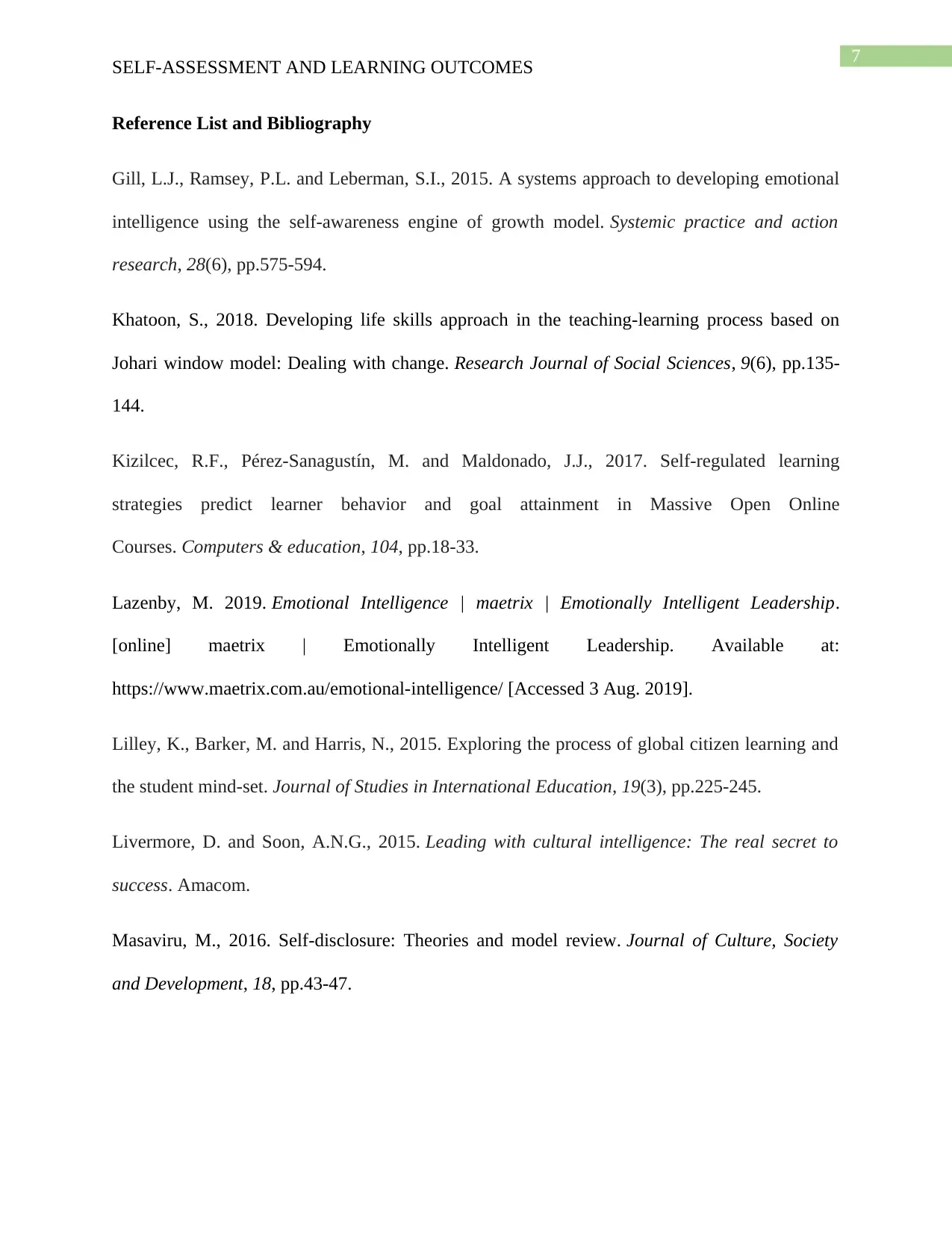
7
SELF-ASSESSMENT AND LEARNING OUTCOMES
Reference List and Bibliography
Gill, L.J., Ramsey, P.L. and Leberman, S.I., 2015. A systems approach to developing emotional
intelligence using the self-awareness engine of growth model. Systemic practice and action
research, 28(6), pp.575-594.
Khatoon, S., 2018. Developing life skills approach in the teaching-learning process based on
Johari window model: Dealing with change. Research Journal of Social Sciences, 9(6), pp.135-
144.
Kizilcec, R.F., Pérez-Sanagustín, M. and Maldonado, J.J., 2017. Self-regulated learning
strategies predict learner behavior and goal attainment in Massive Open Online
Courses. Computers & education, 104, pp.18-33.
Lazenby, M. 2019. Emotional Intelligence | maetrix | Emotionally Intelligent Leadership.
[online] maetrix | Emotionally Intelligent Leadership. Available at:
https://www.maetrix.com.au/emotional-intelligence/ [Accessed 3 Aug. 2019].
Lilley, K., Barker, M. and Harris, N., 2015. Exploring the process of global citizen learning and
the student mind-set. Journal of Studies in International Education, 19(3), pp.225-245.
Livermore, D. and Soon, A.N.G., 2015. Leading with cultural intelligence: The real secret to
success. Amacom.
Masaviru, M., 2016. Self-disclosure: Theories and model review. Journal of Culture, Society
and Development, 18, pp.43-47.
SELF-ASSESSMENT AND LEARNING OUTCOMES
Reference List and Bibliography
Gill, L.J., Ramsey, P.L. and Leberman, S.I., 2015. A systems approach to developing emotional
intelligence using the self-awareness engine of growth model. Systemic practice and action
research, 28(6), pp.575-594.
Khatoon, S., 2018. Developing life skills approach in the teaching-learning process based on
Johari window model: Dealing with change. Research Journal of Social Sciences, 9(6), pp.135-
144.
Kizilcec, R.F., Pérez-Sanagustín, M. and Maldonado, J.J., 2017. Self-regulated learning
strategies predict learner behavior and goal attainment in Massive Open Online
Courses. Computers & education, 104, pp.18-33.
Lazenby, M. 2019. Emotional Intelligence | maetrix | Emotionally Intelligent Leadership.
[online] maetrix | Emotionally Intelligent Leadership. Available at:
https://www.maetrix.com.au/emotional-intelligence/ [Accessed 3 Aug. 2019].
Lilley, K., Barker, M. and Harris, N., 2015. Exploring the process of global citizen learning and
the student mind-set. Journal of Studies in International Education, 19(3), pp.225-245.
Livermore, D. and Soon, A.N.G., 2015. Leading with cultural intelligence: The real secret to
success. Amacom.
Masaviru, M., 2016. Self-disclosure: Theories and model review. Journal of Culture, Society
and Development, 18, pp.43-47.
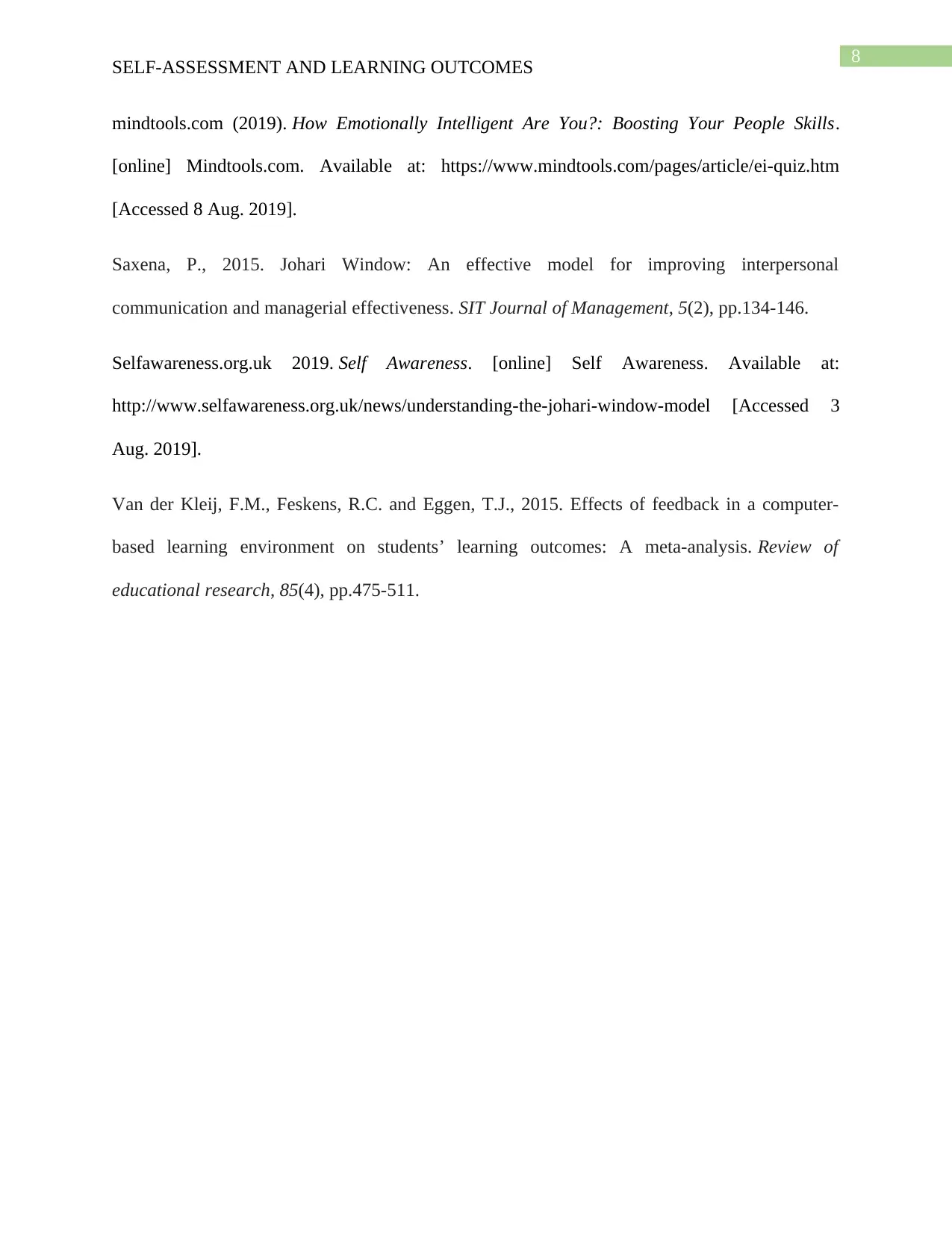
8
SELF-ASSESSMENT AND LEARNING OUTCOMES
mindtools.com (2019). How Emotionally Intelligent Are You?: Boosting Your People Skills.
[online] Mindtools.com. Available at: https://www.mindtools.com/pages/article/ei-quiz.htm
[Accessed 8 Aug. 2019].
Saxena, P., 2015. Johari Window: An effective model for improving interpersonal
communication and managerial effectiveness. SIT Journal of Management, 5(2), pp.134-146.
Selfawareness.org.uk 2019. Self Awareness. [online] Self Awareness. Available at:
http://www.selfawareness.org.uk/news/understanding-the-johari-window-model [Accessed 3
Aug. 2019].
Van der Kleij, F.M., Feskens, R.C. and Eggen, T.J., 2015. Effects of feedback in a computer-
based learning environment on students’ learning outcomes: A meta-analysis. Review of
educational research, 85(4), pp.475-511.
SELF-ASSESSMENT AND LEARNING OUTCOMES
mindtools.com (2019). How Emotionally Intelligent Are You?: Boosting Your People Skills.
[online] Mindtools.com. Available at: https://www.mindtools.com/pages/article/ei-quiz.htm
[Accessed 8 Aug. 2019].
Saxena, P., 2015. Johari Window: An effective model for improving interpersonal
communication and managerial effectiveness. SIT Journal of Management, 5(2), pp.134-146.
Selfawareness.org.uk 2019. Self Awareness. [online] Self Awareness. Available at:
http://www.selfawareness.org.uk/news/understanding-the-johari-window-model [Accessed 3
Aug. 2019].
Van der Kleij, F.M., Feskens, R.C. and Eggen, T.J., 2015. Effects of feedback in a computer-
based learning environment on students’ learning outcomes: A meta-analysis. Review of
educational research, 85(4), pp.475-511.
⊘ This is a preview!⊘
Do you want full access?
Subscribe today to unlock all pages.

Trusted by 1+ million students worldwide
1 out of 9
Related Documents
Your All-in-One AI-Powered Toolkit for Academic Success.
+13062052269
info@desklib.com
Available 24*7 on WhatsApp / Email
![[object Object]](/_next/static/media/star-bottom.7253800d.svg)
Unlock your academic potential
Copyright © 2020–2025 A2Z Services. All Rights Reserved. Developed and managed by ZUCOL.





